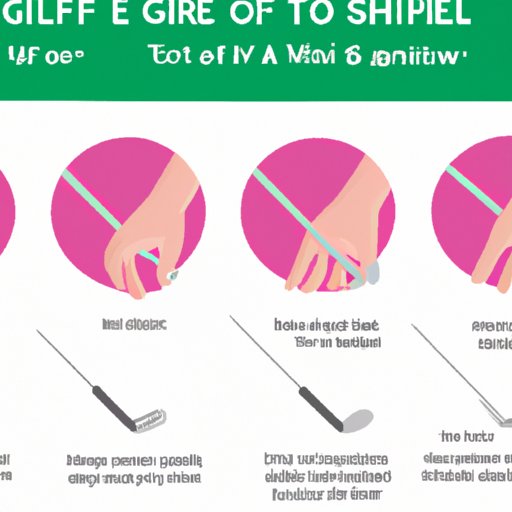Introduction
Golf is not an easy game, and finding the right technique is an essential step for success on the course. One of the essential elements that aid in good performance is getting the proper grip on your golf club. For some golfers, finding and maintaining the correct grip can be a challenge. Not finding the right grip can lead to poor shots, lower accuracy, and reduced performance on the course. This article will provide you with an in-depth guide on how to grip a golf club correctly.
Step-by-Step Guide
Gripping a golf club must be done with an assured and steady hand. The grip should be firm but soft, and certain steps must be followed to achieve the required grip:
- Place the clubface flat on the ground in front of you, making sure it is square.
- Hold the grip of the club with your palm facing towards your body but pointing to the ceiling.
- Place your left hand (for right-handed golfers) at the top end of the grip. The grip should lie in the fingers of your left hand.
- Close your left hand firmly around the grip. Your thumb should run down the top of the club’s grip.
- Place your right hand on the grip slightly below your left. Position the right hand’s lifeline on your left thumb.
- Cover your left thumb with your right hand’s thumb and place your right pinky finger between the index and middle fingers of your left hand, known as the overlapping grip.
- Adjust your grip slightly to fit the club’s shape, ensuring your grip is not too tight or too loose.
Always keep your grip relaxed to maintain consistency in your shots. If you grip the club too tightly, it will negatively affect your swing. Conversely, if you hold the club too loosely, the club will move in your hand, losing its accuracy and power. In the next section, we will discuss the different types of grip.
Types of Grip
There are different types of grips that golfers use, including:
- Overlapping grip: This is the most common grip style used by golfers. It involves placing the pinky finger on your right hand between the left hand’s index and middle fingers.
- Interlocking grip: Here, the index finger of your left hand and the pinky finger of your right hand interlock.
- 10-finger grip: This grip involves placing all ten fingers on the club, unlike the overlapping and interlocking grips.
The overlapping grip provides more wrist action for swings, whereas the interlocking grip offers more stability. The 10-finger grip is mainly used by beginners, juniors, and those with smaller hands. Professional golfers such as Tiger Woods, Rory McIlroy, and Jack Nicklaus use the overlapping grip style. Meanwhile, Phil Mickelson and Ernie Els use the interlocking grip, which helps with accuracy and power.
Common Grip Mistakes
The most common grip mistakes golfers make include:
- Gripping the club too tightly
- Placing the club too far into the palm of their hands
- 2. Gripping unevenly between the right and left-hand.
- Placing their hands far apart or too close together.
If you grip the club too tightly, it will limit your ability to follow through and may lead to injury. Placing the club too far into the palm of your hands also limits wrist action resulting in reduced accuracy and power. Gripping unevenly between the right and left-hand or placing your hands too far apart or too close will also add unnecessary tension. Practicing the correct grip technique regularly can help avoid these grip mistakes, resulting in improved performance on the course.
Importance of Grip
The importance of finding the correct grip in golf cannot be overstated as it affects accuracy, power, and overall performance. It helps in enabling a player to produce consistent shots with ease when the grip is right. A poor grip can lead to loss of control and reduced swing speed making holes potentially harder to complete. A good grip can increase the swing’s speed, timing, and consequently, the golf ball’s distance travelled.
Adjusting Grip
Professional golf players adjust their grip to ensure they get the best out of every shot during a game. The different shots in golf require different grips to achieve the desired outcome. For instance, an open grip can weaken a shot, while a closed grip can strengthen it. To avoid too much swinging action, a player may adjust their grip technique while trying to improve the accuracy and power of a shot.
Drills to Improve Grip
Improvements in grip mastery can be achieved through practicing drills such as:
- Practice squeezing a rubber ball or a soft object to achieve a better grip strength.
- Place a towel on the ground and stand on it while gripping your club; this helps to build grip strength.
- Use a golf club with weights around the grip and execute swings to improve wrist strength and flexibility.
- Practice taking swings with only one hand, alternating between the left and right hand.
Consistency in practice of these drills can go a long way in ensuring improved grip strength and technique, resulting in a satisfying golf game experience.
Conclusion
Gripping the golf club is an essential element in achieving better performance on the golf course. In this article, we have provided a detailed step-by-step guide to achieve a perfect grip, the types of grip styles used, common grip mistakes, the importance of finding the correct grip, adjusting your grip, and drills to improve your grip. By understanding these grip techniques and developing the relevant skills through practice, your golf game will significantly improve.
Don’t forget to practice your grip consistently and seek professional advice if necessary to ensure optimal performance on the course.
